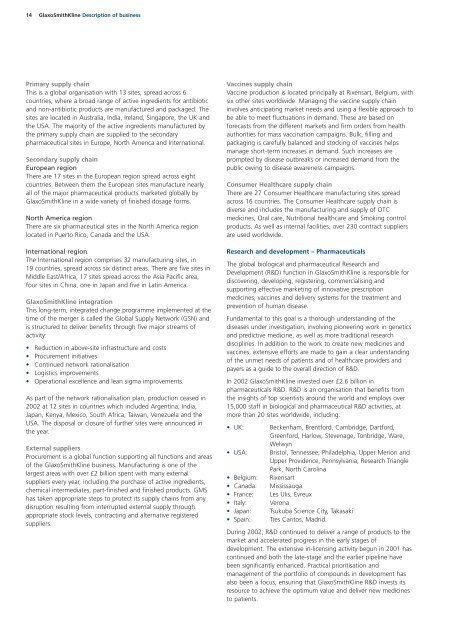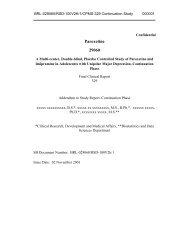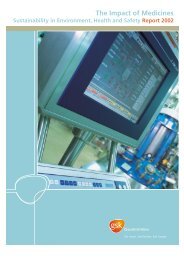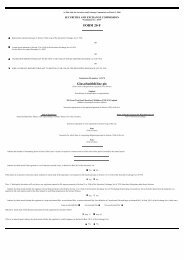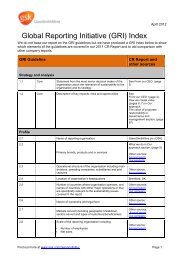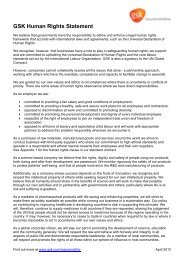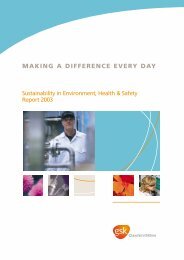GSK Annual Report 2002
GSK Annual Report 2002
GSK Annual Report 2002
Create successful ePaper yourself
Turn your PDF publications into a flip-book with our unique Google optimized e-Paper software.
14 GlaxoSmithKline Description of business<br />
Primary supply chain<br />
This is a global organisation with 13 sites, spread across 6<br />
countries, where a broad range of active ingredients for antibiotic<br />
and non-antibiotic products are manufactured and packaged. The<br />
sites are located in Australia, India, Ireland, Singapore, the UK and<br />
the USA. The majority of the active ingredients manufactured by<br />
the primary supply chain are supplied to the secondary<br />
pharmaceutical sites in Europe, North America and International.<br />
Secondary supply chain<br />
European region<br />
There are 17 sites in the European region spread across eight<br />
countries. Between them the European sites manufacture nearly<br />
all of the major pharmaceutical products marketed globally by<br />
GlaxoSmithKline in a wide variety of finished dosage forms.<br />
North America region<br />
There are six pharmaceutical sites in the North America region<br />
located in Puerto Rico, Canada and the USA.<br />
International region<br />
The International region comprises 32 manufacturing sites, in<br />
19 countries, spread across six distinct areas. There are five sites in<br />
Middle East/Africa, 17 sites spread across the Asia Pacific area,<br />
four sites in China, one in Japan and five in Latin America.<br />
GlaxoSmithKline integration<br />
This long-term, integrated change programme implemented at the<br />
time of the merger is called the Global Supply Network (GSN) and<br />
is structured to deliver benefits through five major streams of<br />
activity:<br />
• Reduction in above-site infrastructure and costs<br />
• Procurement initiatives<br />
• Continued network rationalisation<br />
• Logistics improvements<br />
• Operational excellence and lean sigma improvements.<br />
As part of the network rationalisation plan, production ceased in<br />
<strong>2002</strong> at 12 sites in countries which included Argentina, India,<br />
Japan, Kenya, Mexico, South Africa, Taiwan, Venezuela and the<br />
USA. The disposal or closure of further sites were announced in<br />
the year.<br />
External suppliers<br />
Procurement is a global function supporting all functions and areas<br />
of the GlaxoSmithKline business. Manufacturing is one of the<br />
largest areas with over £2 billion spent with many external<br />
suppliers every year, including the purchase of active ingredients,<br />
chemical intermediates, part-finished and finished products. GMS<br />
has taken appropriate steps to protect its supply chains from any<br />
disruption resulting from interrupted external supply through<br />
appropriate stock levels, contracting and alternative registered<br />
suppliers.<br />
Vaccines supply chain<br />
Vaccine production is located principally at Rixensart, Belgium, with<br />
six other sites worldwide. Managing the vaccine supply chain<br />
involves anticipating market needs and using a flexible approach to<br />
be able to meet fluctuations in demand. These are based on<br />
forecasts from the different markets and firm orders from health<br />
authorities for mass vaccination campaigns. Bulk, filling and<br />
packaging is carefully balanced and stocking of vaccines helps<br />
manage short-term increases in demand. Such increases are<br />
prompted by disease outbreaks or increased demand from the<br />
public owing to disease awareness campaigns.<br />
Consumer Healthcare supply chain<br />
There are 27 Consumer Healthcare manufacturing sites spread<br />
across 16 countries. The Consumer Healthcare supply chain is<br />
diverse and includes the manufacturing and supply of OTC<br />
medicines, Oral care, Nutritional healthcare and Smoking control<br />
products. As well as internal facilities, over 230 contract suppliers<br />
are used worldwide.<br />
Research and development – Pharmaceuticals<br />
The global biological and pharmaceutical Research and<br />
Development (R&D) function in GlaxoSmithKline is responsible for<br />
discovering, developing, registering, commercialising and<br />
supporting effective marketing of innovative prescription<br />
medicines, vaccines and delivery systems for the treatment and<br />
prevention of human disease.<br />
Fundamental to this goal is a thorough understanding of the<br />
diseases under investigation, involving pioneering work in genetics<br />
and predictive medicine, as well as more traditional research<br />
disciplines. In addition to the work to create new medicines and<br />
vaccines, extensive efforts are made to gain a clear understanding<br />
of the unmet needs of patients and of healthcare providers and<br />
payers as a guide to the overall direction of R&D.<br />
In <strong>2002</strong> GlaxoSmithKline invested over £2.6 billion in<br />
pharmaceuticals R&D. R&D is an organisation that benefits from<br />
the insights of top scientists around the world and employs over<br />
15,000 staff in biological and pharmaceutical R&D activities, at<br />
more than 20 sites worldwide, including:<br />
• UK: Beckenham, Brentford, Cambridge, Dartford,<br />
Greenford, Harlow, Stevenage, Tonbridge, Ware,<br />
Welwyn<br />
• USA: Bristol, Tennessee; Philadelphia, Upper Merion and<br />
Upper Providence, Pennsylvania; Research Triangle<br />
Park, North Carolina<br />
• Belgium: Rixensart<br />
• Canada: Mississauga<br />
• France: Les Ulis, Evreux<br />
• Italy: Verona<br />
• Japan: Tsukuba Science City, Takasaki<br />
• Spain: Tres Cantos, Madrid.<br />
During <strong>2002</strong>, R&D continued to deliver a range of products to the<br />
market and accelerated progress in the early stages of<br />
development. The extensive in-licensing activity begun in 2001 has<br />
continued and both the late-stage and the earlier pipeline have<br />
been significantly enhanced. Practical prioritisation and<br />
management of the portfolio of compounds in development has<br />
also been a focus, ensuring that GlaxoSmithKline R&D invests its<br />
resource to achieve the optimum value and deliver new medicines<br />
to patients.


